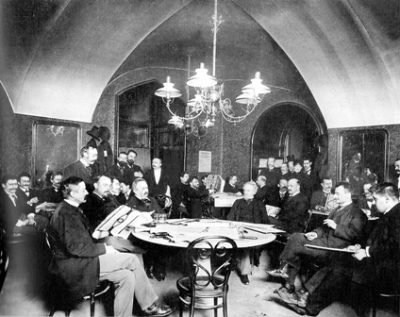By
Robert Kilborn
A shrewd November dusk de-illuminates an opaque door on rue de la Montagne near the corner of boulevard De Maisonneuve at the very heart of Montreal’s circulatory system. A Chinese gong sounds when you open the door and enter The Ten Thousand Things. In the near distance, you hear a piano and a tenor voice murmuring fragments of Leonard Cohen’s “Everybody Knows.” Sugar maple burns in the fireplace, the caramel of freshly roasted coffee sweetens the air. Apricot-coloured lights guide you past the umbrella and coat stands, the white marble counters with their mottlings of black and grey, two gleaming silver and gold espresso machines, and ziggurats of sandwiches and pâtisseries in etched glass vitrines.
Outside, soft asterisks of snow fall against the stars.
You arrive at a loft-like bower lit up by two chandeliers made of wine glasses hanging like transparent fruit. On gray brick walls, scores of watercolours and pen and ink drawings depict the cobblestone streets, horse-drawn carriages, and outdoor markets of Old Montreal. Groups of men and women in suits or leather jackets gather around the white marble and black ironwork tables, sipping wine or coffee, perusing The Globe and Mail or Le Devoir, or chatting about the Paris shooting or London beheading. From her spot on top of the old school television, Lhasa, an enormous long-haired grey cat of indeterminate breed, stares at you. Nelligan the Skye Terrier slumbers on the Persian carpet next to a Sassanid Immortal, who brandishes a scimitar smeared with woven blood, and spurs his armoured horse into battle against the Arab invaders and their new creed of Islam. You find a vacant table and sit down. The dancer Roger Stille cries out for silence with a juridical flourish of “Oyez, Oyez.” Like a ribbon-twirling gymnast, he waves his burgundy scarf above his head; a ceiling fan tugs the scarf up, then lets it drop like wine swirling in a glass.
Onto the postage stamp stage next to the Chickering baby grand piano, Margaret van Dyck, artist, goth dandy, alights. Her pale omniscient face, framed by Louise Brooks hair, blanches in the spotlight. She speaks in her signature quick, precise, staccato manner:
“In defiance of the cynicism, philistinism, and sneering attitudes of our age, we call for a return to the obstetrics of reverence, awe, and gratitude. We makers, cyphers, Morpheans and Pataphysicians are not about hero- or heroine-worship. We are about artistry, critical thinking, curiosity, passion, and the 18th century idea of the amateur.”
Arbiter elegantiarum Anna Mattiuzzo opens her pillow book, becomes pensive, and writes down her musings, laughing softly to herself.
“We revivify the idea and practice of the amateur in the 18th century sense of “lover”: lover of learning for its own sake; lover of mental culture and vibrant salon discourse; lover of beauty, wisdom and pleasure; lover of the judicious use of the noble semicolon.”
Smiles punctuate the room. A steady rain of applause.
“Our motto is William Blake’s Enthusiastic admiration is the first principle of knowledge and its last. We move through the world leaving people more alive to the things we love. Among our heroes is the divine Walter Pater. As it was for Oscar Wilde, Pater’s Studies in the History of the Renaissance is among our Golden Books. As Beckett writes of Proust’s epic, It is not about something, it is that something itself.”
Anthony Jenkins the caricaturist-illustrator and Henry Kolenko the impresario, who had been engaged in arm wrestling over a bill, now listen with keener attention. Craig Cormack, the Taoist master of Chi Kung and other Chinese mysteries, works the acupoints of his temples.
“Those who ask us to justify or, worse, explain our declarations, jokes, and aphorisms, are instantly directed to the best local used book emporia for several years’ voluntary incarceration.”
The proprietors of the Odyssey Bookstore, Cheap Thrills, and The Word nod as one, a benign Cerberus, curators of laughter and grief.
“Those whose bones we plow over: All enemies of art, poetry, science, and generous, intellectual, and imaginative values. The plodding and platitudinous mystagogues of Critical Theory and Cultural Studies. Psyches warped by the pernicious, reductive, fashionable nonsense inculcated at so many of our universities. Tin-eared academic philistines. Perpetrators of cement-mixer prose dense with such jargon as “hegemonic,” “problematize,” and “privileging”.
“Yay!” cry out a quorum of McGill and Université de Montréal professors at the academic table, stamping their feet; books of theory fall off the shelves, knocking a row of Derrideans, Lacanians, and Foucauldians on their heads; the professors drag the unconscious bodies outside. French professor Joëlle Sandt says to her table: “Ce n’est pas le salon de Madame de Staël.”
“We further execrate narrow philosophers, vapid psychologists, witless social reformers, and all others embraced as harbingers of utopia. In this execration we include the radical students and soi-disant progressives who shout down the free speech of those who dare disagree with them, true believers who want to persecute all who do not share their brand of enlightenment, sexual obsessives who can’t wrap their tongues around what other people do in bed, and people who talk loudly on their cellphones.”
Laughter and applause. Margaret van Dyck smiles, bows, and butterflies from the stage to the table next to yours. Lhasa brushes past your legs. Nelligan trails her. Someone sits at the Chickering and plays the aria of Bach’s Goldberg Variations in the withdrawn but expansive style of Glenn Gould.
At that moment, the gunmen enter.



No Comments Yet!
You can be first to comment this post!